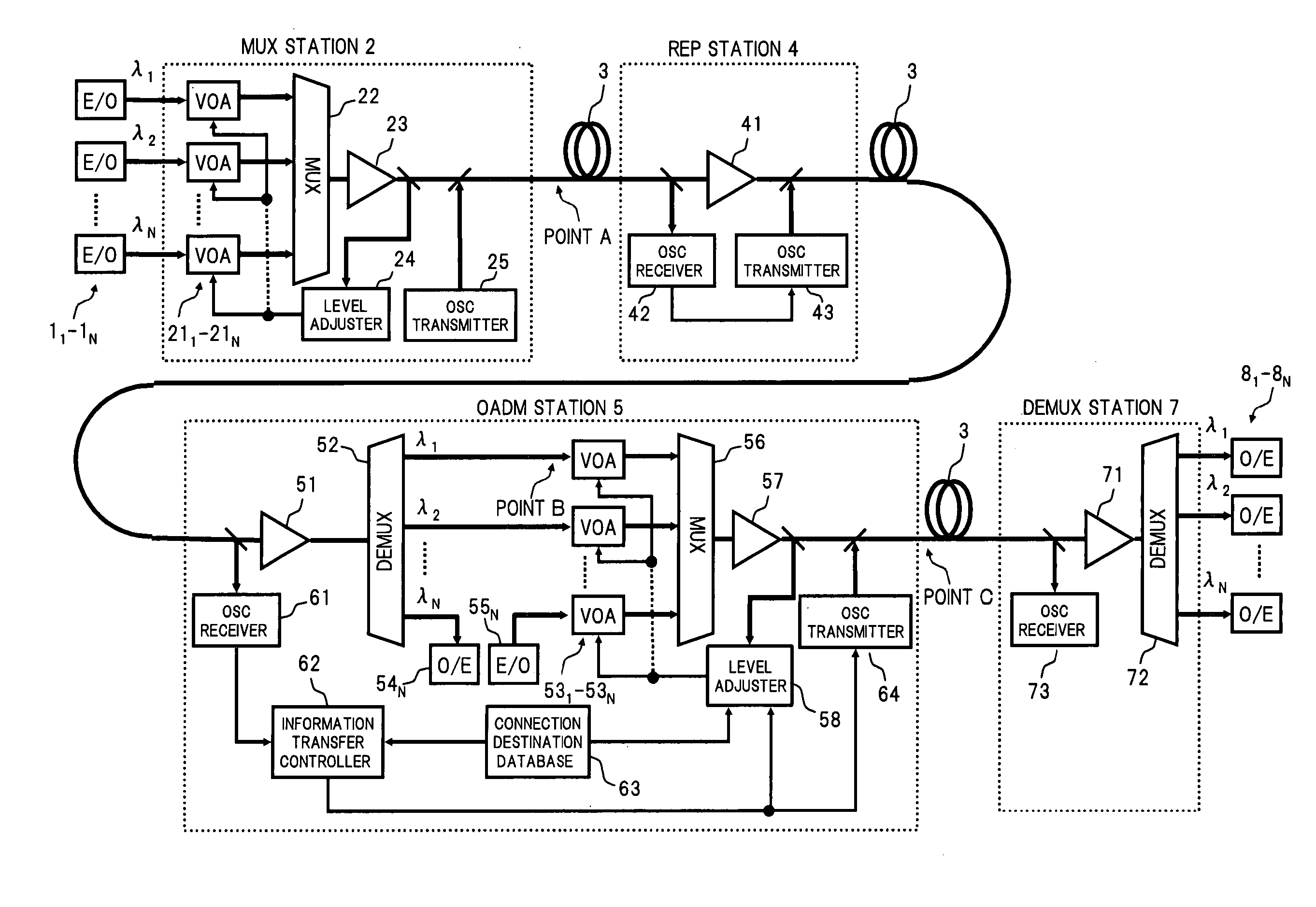Wavelength division multiplexing optical transmission system
- Summary
- Abstract
- Description
- Claims
- Application Information
AI Technical Summary
Benefits of technology
Problems solved by technology
Method used
Image
Examples
first embodiment
[0041]FIG. 1 is a diagram showing a configuration of a WDM optical transmission system according to the present invention.
[0042] In FIG. 1, a WDM optical transmission system in the present embodiment comprises, for example: a plurality of (here, N) optical transmitters (E / O) 11 to 1N; a wavelength multiplexing (MUX) station 2 which multiplexes optical signals output from the respective optical transmitters 11 to 1N to generate WDM light and transmits the WDM light to an optical transmission line 3 together with an optical supervisory channel (OSC); a repeating and amplifying station (REP) 4 arranged on the optical transmission line 3 for amplifying and outputting the input WDM light; an optical add-drop station (OADM) 5 arranged on the optical transmission line 3 for changing over the path of optical signals of respective wavelengths; a wavelength demultiplexing (DEMUX) station 7 which generates optical signals of respective wavelengths by demultiplexing the WDM light propagating on...
second embodiment
[0086] Next the present invention will be described below.
[0087] In the first embodiment, the description was for a case in which the control of the optical signal power for the respective wavelengths λ1 to λN included in the WDM light is performed by using the variable optical attenuator provided for each wavelength. However, other than the above described method of controlling the optical signal power for the respective wavelengths λ1 to λN, there are known other methods of controlling a tilt of power with respect to the wavelengths of all optical signals included in the WDM light, for example, by using a gain tilt characteristic of a rare earth doped optical fiber amplifier, or by adjusting a plurality of wavelengths of pumping light or power ratio in a Raman amplifier. Therefore in the second embodiment, a WDM optical transmission system in which the level control for each wavelength by using the variable optical attenuator in the first embodiment, and the above described tilt c...
third embodiment
[0096] Next the present invention will be described below.
[0097] In the third embodiment, as an application example of the aforementioned first embodiment, a WDM optical transmission system also corresponding to a pre-emphasis control function will be described. Pre-emphasis control refers to control for rendering the power of optical signals of the respective wavelengths nonuniform in the wavelength multiplexing station on the transmission side, in order to equalize the optical signal to noise ratio (OSNR) in each wavelength after the WDM transmission.
[0098]FIG. 9 is a diagram showing the configuration of a main part of the WDM optical transmission system according to the third embodiment of the present invention.
[0099] The overall configuration of the WDM optical transmission system in this embodiment is a system configuration for performing two-way WDM optical transmission in which two configurations of the first embodiment are combined so as to correspond to up link and down l...
PUM
 Login to View More
Login to View More Abstract
Description
Claims
Application Information
 Login to View More
Login to View More - R&D
- Intellectual Property
- Life Sciences
- Materials
- Tech Scout
- Unparalleled Data Quality
- Higher Quality Content
- 60% Fewer Hallucinations
Browse by: Latest US Patents, China's latest patents, Technical Efficacy Thesaurus, Application Domain, Technology Topic, Popular Technical Reports.
© 2025 PatSnap. All rights reserved.Legal|Privacy policy|Modern Slavery Act Transparency Statement|Sitemap|About US| Contact US: help@patsnap.com



